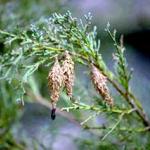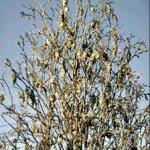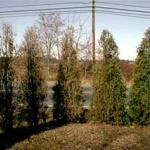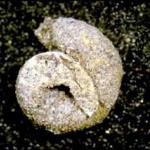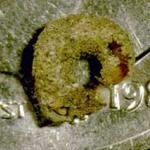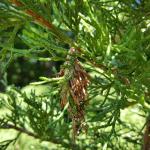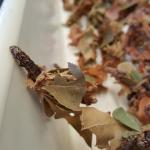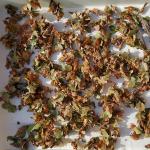Bagworm
Order: Lepidoptera
Family: Psychidae
Thyridopteryx ephemeraeformis
Overview
Bagworms are native defoliators occurring in the eastern United States with a large geographic range that includes parts of the central US as well. The caterpillars of this species are often a pest of arborvitae (Thuja spp.) and eastern red cedar (Juniperus virginiana), however they are capable of seriously impacting a wide variety of both deciduous and coniferous host plants. Other hosts include but are not limited to pine, sycamore, maple, locust, oak, and boxelder. Bagworms feed on ornamental trees and shrubs, specifically on their leaves, which can result in the death of the host plant if defoliation is severe enough, or occurs in multiple growing seasons. They may sometimes remove bark or other plant parts, to incorporate into the “bags” they create around themselves. Additional species of bagworms exist, but T. ephemeraeformis may often be the most damaging to host plant health. Historically, bagworms were not thought to overwinter in Massachusetts. In recent years, this species seems entirely capable of overwintering in the Bay State, possibly with the assistance of climate change.
Host Plants
Common host plants include: arborvitae (Thuja spp.), juniper (Juniperus spp.), oak (Quercus spp.), and sycamore (Platanus spp.). Additional host plants include but are not limited to: black locust (Robinia spp.), boxelder (Acer negundo), buckeye (Aesculus spp.), eastern white pine (Pinus strobus), elm (Ulmus spp.), ligustrum (Ligustrum japonica), linden (Tilia spp.), live oak (Quercus virginiana), London planetree (Platanus x acerifolia), pine (Pinus spp.), maple (Acer spp.), red cedar (Juniperus virginiana), viburnum (Viburnum spp.), and willow (Salix spp.). Bagworm larvae (caterpillars) feed on the leaves or needles of their host plants, causing defoliation.
Identification/Life Cycle
Adult female bagworms do not look like moths, but rather soft, yellow-white caterpillar-like organisms that are devoid of hairs, eyes, wings, legs, antennae, and functional mouthparts. Adult females never leave the protective case/bag that they create as a larva. Adult males, however, emerge as moths with wings spanning 1 inch and antennae and are covered in dark hairs. The male has a very short lifespan, measured in days, during which time he must find the female to mate. Neither adult feeds.
Females can produce 500-1,000 eggs which overwinter in the bag. The bag is made of silk, leaves, and sometimes twigs, bark, and berries. Egg hatch may occur around mid-June in southern New England (600-900 GDD’s, base 50°F). Newly hatched larvae will disperse by crawling from the bag or they may balloon from the location where they hatched, a short distance.
Young larvae feed on the upper side of the host plant leaves. Older larvae feed on the lower leaf surface and may consume everything except the larger leaf veins. As the larva grows, the bag is enlarged. A full grown larva may have a bag measuring 1.18-2 inches in length. Pupation occurs inside the bag which serves the same function as a cocoon. Pupation occurs in late September into October in New England. There is only one generation per year in the northern portion of this insect’s range.
This species of bagworm is native to North America. It is distributed throughout the eastern United States to Nebraska and has historically had a northern limit to its range described as southern Michigan and in most cases at points similar in latitude. However, within the last decade, bagworms have been detected in new areas such as parts of northern Michigan and southern Ontario.
Some recent studies have considered how climate change may impact the northern boundary of this insect’s known range. One such study found that over-winter egg mortality is the biggest constraint on bagworm survival beyond their northern range limit. Egg mortality over the winter is directly related to temperatures falling below bagworm eggs’ physiological limit. Therefore, as climate change is predicted to increase minimum winter temperatures, this species may be impacted by that change. That said, predicting changes in insect herbivores due to climate change is incredibly complex. Entomologists need to consider temperature, photoperiod, individual insect herbivore phenotypic and genotypic flexibility, and many other factors.
Damage
Host plant damage is caused by the bagworm larvae (caterpillars) when they feed on the tree and shrub leaves, resulting in defoliation. Bagworm feeding may be of particular concern in ornamental parks and also in urban areas. Brown spots form on leaves from the feeding of young larvae. On broad-leaved hosts, older larvae feed from the leaf underside and will consume everything except for the midvein. Because female dispersal is limited, a single host may suffer great damage in a season. Spindle-shaped bags may remain on the plant even after management has been successful (if the management technique did not involve bag removal).
Injury to hosts can be quite severe when populations are high. Complete defoliation and plant death can result from the feeding activity of this pest. Given that the female does not fly, injury usually appears severe on one plant and then often radiates down a hedgerow from that one initially infested plant to others. Extended warm autumns enhance its survival in New England.
Management Strategies:
The management of bagworms can be accomplished by handpicking and destroying bags before the eggs hatch and new caterpillars begin their feeding. The natural enemies of bagworms, such as parasitic wasps and predators like white footed mice and certain species of birds, can attack them and reduce their numbers. A sex pheromone specific to the bagworm has been identified that when used in combination with traps, can capture the adult male moths and successfully interrupt their mating behavior, thus impacting a local population.
Cultural/Mechanical Management:
In small populations on trees and shrubs where they can be safely reached, bagworm bags may be handpicked from the host and destroyed: placed in a sealed plastic bag and disposed of, or submerged in a bucket of soapy water. This can be done at any point during the season, but particularly before the new generation of bagworms hatch from the overwintered eggs.
Biological Control/Natural Enemies:
At least 11 species of parasitic wasps attack these insects, including ichneumonids. Some examples of parasitic wasps attacking bagworms include: Pimpla disparis, Itoplectis conquisitor, and Gambrus ultimus. Schaffner (1959) also lists the following natural enemies of bagworm that were collected from samples in Massachusetts, New York, New Jersey, Pennsylvania, Maryland, Delaware, and Missouri: Anachaetopsis spp., Phorocera claripennis, and Zenillia blanda (Diptera), as well as Brachymeria ovata ovata, Habrocytus thyridopterigis, Itoplectis conquisitor, and Phobetes thyridopteryx (Hymenoptera). Adding flowering plants to the landscape may increase the presence of certain parasitic wasps and the percentage of bagworm parasitism. Predators include white footed mice and certain birds.
Chemical Management:
Chemical management options for bagworms include both contact and systemic insecticides. The caterpillars themselves are well hidden within the protective bags they create.
Reduced risk, contact insecticides such as Bacillus thuringiensis kurstaki (B.t.k) can be effective on younger (smaller, newly hatched and feeding) larvae. Chlorantraniliprole was shown in a study to be as effective at managing bagworms as bifenthrin and spinosad (Rhainds and Sadof, 2009). All chemical management options are most effective when directed against bagworms that are still small in size. Thorough coverage of foliage is required.
Soil application of dinotefuran was also tested and determined to be effective at managing young bagworms, particularly on small evergreen shrubs (Rhainds and Sadof, 2009).
Many additional active ingredients are labeled for use against bagworms in Massachusetts, including but not limited to: acephate (NL), azadirachtin (NL), carbaryl (L), Chromobacterium subtsugae (NL), cyfluthrin (NL), deltamethrin (L), emamectin benzoate (L), gamma-cyhalothrin (L), indoxacarb (L), lambda-cyhalothrin (larva only) (L), malathion (L), permethrin (L), spinetoram+sulfoxaflor (N), tau-fluvalinate (NL), and tebufenozide (NL). Contact a Massachusetts licensed pesticide applicator for assistance.
Read and follow all label instructions for safety and proper use. If this information contradicts language on the label, follow the most up-to-date instructions on the product label. Always confirm that the site you wish to treat and the pest you wish to manage are on the label before using any pesticide. Active ingredients labeled "L" indicate some products containing the active ingredient are labeled for landscape uses on trees or shrubs. Active ingredients labeled "N" indicate some products containing the active ingredient are labeled for use in nurseries. Always confirm allowable uses on product labels. This active ingredient list is based on what was registered for use in Massachusetts at the time of publication. This information changes rapidly and may not be up to date. If you are viewing this information from another state, check with your local Extension Service and State Pesticide Program for local uses and regulations.
See the Professional Insect & Mite Management Guide for Woody Plants for more information about bagworm management on trees and shrubs.
References
PennState Extension: Bagworm
Purdue University Extension Entomology: Bagworms
University of Maryland Extension: Bagworms on Trees and Shrubs
